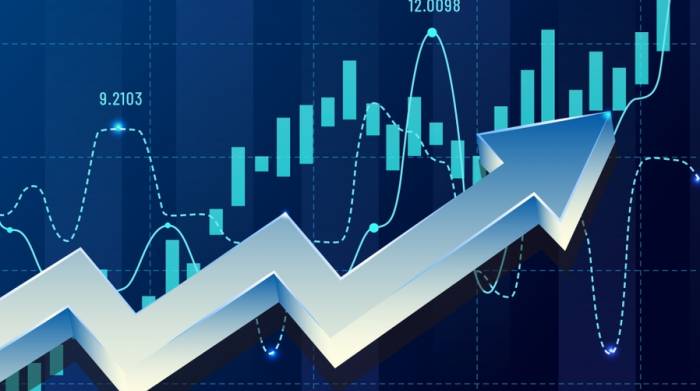Big Three's U.S. Market Crowding: 10% Global Value?
The concentration of the U.S. stock market is currently at one of its highest levels in history. Recent market movements, fueled by leading tech stocks, have propelled both the Nasdaq Composite and the S&P 500 indices to record highs, fostering a cash influx that has raised concerns among financial analysts about potential market pullbacks. Historically, such a concentrated capital flow signals a bullish phase for U.S. equities, often translating into higher returns. While some analysts remain optimistic about the future due to factors like advancements in artificial intelligence (AI), they also heed the warning signs of market encroachment.
The excitement surrounding AI has lit a fire under the market. For example, just last Wednesday, the S&P 500 surged ahead of the Dow Jones Industrial Average, logging gains of over 0.9%. Figures from Dow Jones Market Data indicate that similar divergences in performance have occurred at critical market junctures before, notably 20 times in the year 2000, which coincided with the bursting of the dot-com bubble. Similar patterns emerged during market sell-offs in late 2018 and late 2021. As of now, 2024 has already witnessed this phenomenon three times.
Boris Schlossberg, a macro strategist at BK Asset Management, provided insights in an interview, noting that the gap between the S&P 500 and the Dow Jones has expanded to approximately 10% this year. This widening differential can be attributed to discrepancies in the composition of the indices alongside their respective calculation methodologies. Major technology firms have amplified their influence, resulting in a market capitalization-weighted S&P 500 that outpaces its counterparts.
Research from broker Strategas highlights how companies like Microsoft, Apple, and Nvidia—whose market values have exceeded an astounding $3 trillion—now constitute over 20% of the S&P 500's overall weighting. The ramifications of this concentration are striking; the market capitalization of U.S. stocks has grown to over 60% of the global total, with the three tech giants alone representing a whopping 10.6% of global market capitalization—a record-setting figure.
Yet, with this concentration also comes risk, especially considering the uncertainties surrounding monetary policy and the fervent expectations for corporate performance. Schlossberg cautions that should these tech behemoths begin to descend in value, the S&P 500 would undoubtedly suffer significant losses. However, he remains hopeful that the enduring drive for AI applications will sustain overall profitability.

In the short term, some experts are concerned that the rapid appreciation of tech stocks may have overshot potential future gains. Mark Hackett, chief of investment research at Nationwide, conveys his apprehension from a macro perspective, suggesting that while current valuations seem feasible, the lack of breadth in the market could foreshadow volatility. "I believe the market has advanced rather far and fast, which makes me nervous—at least for the near term," he stated.
Historically speaking, Morgan Stanley’s asset management analyst Michael J. Mauboussin recently released a report indicating that while the U.S. stock market does exhibit signs of concentration, it remains far from being the most concentrated in the world. Among the top ten largest markets, the U.S. ranks fourth from the bottom, trailing behind nations such as India, Japan, and China, with Switzerland, France, and Australia demonstrating the most dramatic levels of concentration. Presently, the top ten firms in the U.S. account for 35% of total market capitalization, a high point in history.
Reflecting back on data from 1989 to 2011 across 47 global markets, the average weight represented by the top ten stocks was 48%. In contrast, over the last decade (2014 to 2023), the average weighted contribution of the top ten American stocks to total market capitalization languished at 19%, while their share of overall returns hovered around 47%. However, in the last year, these figures have surged to 27% and 69% respectively. Remarkably, even after a decade-long accumulation of market concentration, the U.S. stock market still stands as one of the most diverse in the global arena.
When we evaluate returns, an uptick in concentration typically correlates with higher yields; conversely, periods of declining concentration often yield returns lower than the historical average. The late 1990s internet boom serves as a salient example where the S&P 500 commanded a compound annual return of 23.5% from 1994 to 1999, only to nosedive to a mere 3.6% from 2000 to 2013.
Overall, rising concentration is a defining characteristic of U.S. stock market bull runs. Looking forward, the sustainability of this trend appears tethered to advances in artificial intelligence. Julian Emanuel, a strategist at Evercore ISI, recently revised his year-end S&P 500 target upward from 4,750 to 6,000. He interprets the robust economic backdrop coupled with the buoyancy provided by AI applications as a catalyst for increased corporate earnings and market valuations.
Emanuel recalls the warnings issued by former Federal Reserve Chairman Alan Greenspan in 1996 regarding "irrational exuberance" in the wake of the internet and personal computing boom. Following those remarks, the ensuing market rebound continued for over three years. "In other words, the stock market's enthusiasm for new technologies may persist longer than skeptics anticipate," he observed, adding that even though current valuations echo those seen during the peak of the pandemic and the dot-com bubble, such valuations might remain elevated for an extended timeframe.
Circling back to recent analysis, Citigroup also raised its S&P 500 year-end target to 5,600. Chief strategist Scott Chronert argues that ongoing upgrades in earnings projections and profit growth will eventually spill over beyond technology stocks, driving further increases in the indices.
Leave A Comment